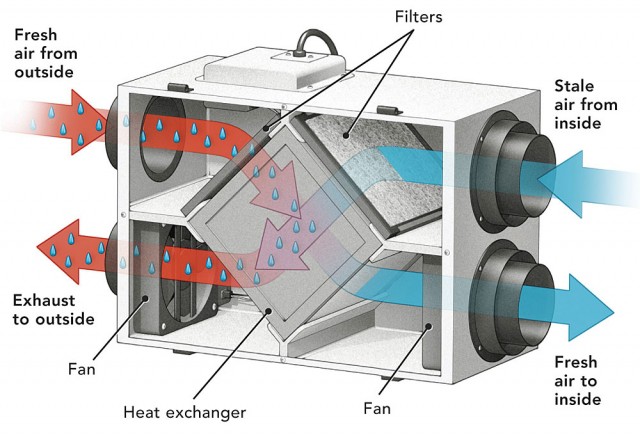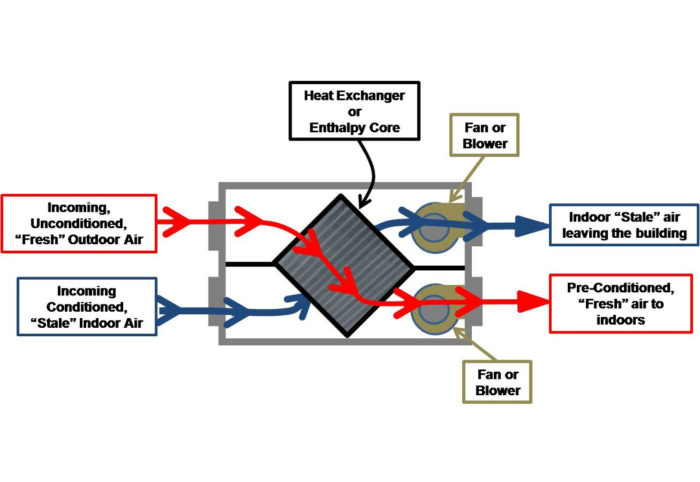The All-Inclusive Overview to the Uses of Heat Recovery Ventilation in Modern Buildings
Heat Recovery Ventilation (HRV) systems stand for a significant advancement in developing modern technology (HRV Heat Recovery Ventilation). They offer an approach for exchanging stagnant indoor air with fresh exterior air while minimizing energy loss. This method not only enhances interior air quality however also contributes to energy performance in both residential and commercial structures. Recognizing the different applications and advantages of HRV can reveal its essential function in modern-day design and sustainability efforts. The ramifications of this technology deserve discovering better
Comprehending Heat Recovery Ventilation Equipments

Although many modern structures focus on power performance, comprehending warm recuperation ventilation (HRV) systems is crucial for optimizing indoor air high quality and lowering energy intake. HRV systems work by transferring heat from stale interior air to inbound fresh air, effectively maintaining comfortable indoor temperatures while reducing energy loss. These systems include a warmth exchanger, followers, and ductwork that facilitate the circulation of air. During winter season, HRV systems record and recycle warmth from the outward bound air, while in summer season, they can aid cool down incoming air. By continually exchanging air, HRV systems also lower moisture and the concentration of interior toxins. Correct installment and upkeep of HRV systems are crucial for their performance and performance in boosting general building performance and convenience.
Advantages of Heat Recovery Ventilation
Heat recovery ventilation systems use many benefits that enhance both energy effectiveness and indoor air quality in modern structures. By catching and reusing power from exhaust air, these systems greatly lower heating and cooling costs, leading to reduced energy consumption. In addition, they preserve a stable circulation of fresh outside air, reducing the threat of interior air pollutants and irritants. This continual exchange aids regulate humidity degrees, avoiding mold and mildew development and guaranteeing a much healthier living setting. Additionally, HRV systems contribute to sustainability goals by lowering total carbon impacts. Their capability to enhance air flow without compromising thermal comfort makes them a valuable enhancement to contemporary building layout, promoting both economic and environmental advantages.
Applications of HRV in Residential Structures
As homeowners increasingly focus on energy performance and indoor air quality, the applications of warmth healing air flow (HRV) systems in residential buildings have become a lot more prevalent. HRV systems are specifically beneficial in securely sealed homes, where preserving fresh air flow is crucial for avoiding wetness build-up and interior pollutants. They successfully transfer warmth from outgoing stagnant air to inbound fresh air, reducing energy costs related to home heating and air conditioning. Furthermore, HRVs can boost convenience degrees by managing moisture and temperature. They are also adaptable for various property styles, consisting of single-family homes and multi-unit structures. Overall, integrating that site HRV systems supports lasting living techniques while guaranteeing a healthier indoor atmosphere for passengers.
HRV in Industrial and Commercial Setups
In industrial and industrial setups, the try this web-site application of warm recovery ventilation (HRV) systems has actually come to be significantly essential for optimizing power performance and keeping air high quality. These systems successfully transfer heat from exhaust air to inbound fresh air, lowering the requirement for extra heating or cooling. This not just reduces energy costs yet additionally adds to sustainability campaigns. Industries such as manufacturing, warehousing, and office complex profit considerably from HRV systems, as they help manage temperature level and humidity degrees, making sure a comfortable and effective environment. HRV systems aid in getting rid of pollutants and excess moisture, enhancing indoor air quality. As laws around air quality come to be more stringent, the adoption of HRV modern technology is most likely to expand, making it an important element of modern business and industrial facilities.
Future Trends in Heat Recovery Ventilation Modern Technology

Often Asked Inquiries
How Does Heat Recovery Ventilation Impact Indoor Air High Quality?
Heat recovery ventilation substantially boosts indoor air quality by continuously trading stale indoor air with fresh exterior air while recouping power. This procedure minimizes contaminants, maintains optimal humidity levels, and assures a much healthier atmosphere for passengers.
Can HRV Systems Be Installed in Existing Structures?
HRV systems can without a doubt be set up in existing buildings. Retrofitting might need modifications to ductwork and air flow designs, but it considerably enhances energy performance and indoor air top quality, making it a practical option for older frameworks.
What Maintenance Is Required for HRV Solutions?

Exist Certain Climates Where HRV Is Much More Effective?
Heat recovery ventilation systems are specifically efficient in climates with substantial temperature differences between seasons. These systems optimize energy performance by recuperating heat from exhaust air, making them ideal for both cold and reasonably warm environments.
Just How Do HRV Solutions Affect Energy Bills?
